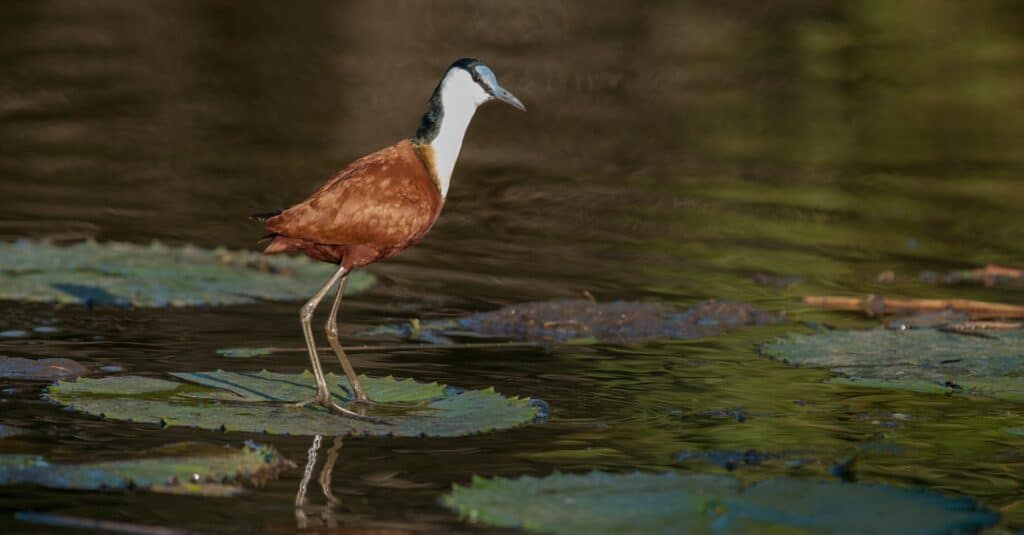Jacana
.jumbotron {
background-image: url(“https://a-z-animals.com/media/2021/11/jacana-400×300.jpg”);
}
}
@media only screen and (min-width: 641px) and (max-width: 920px) {
.jumbotron {
background-image: url(“https://a-z-animals.com/media/2021/11/jacana-470×370.jpg”);
}
}
@media only screen and (min-width: 921px) {
.jumbotron {
background-image: url(“https://a-z-animals.com/media/2021/11/jacana.jpg”);
}
}
Jacana
Jacanidae
The jacana has the ability to swim underwater
Jacana Scientific Classification
- Kingdom
- Animalia
- Phylum
- Chordata
- Class
- Aves
- Order
- Charadriiformes
- Family
- Jacanidae
- Genus
- Jacana Brisson
- Scientific Name
- Jacanidae
Read our Complete Guide to Classification of Animals.
Jacana Conservation Status
Jacana Facts
- Prey
- Insects, snails, worms, crabs, fish, mollusks, and seeds
- Fun Fact
- The jacana has the ability to swim underwater
- Estimated Population Size
- millions
- Biggest Threat
- habitat loss
- Most Distinctive Feature
- The long legs and feet
- Other Name(s)
- Lilly trotters or lotus birds
- Wingspan
- 20 inches
- Incubation Period
- 22-28 days
- Habitat
- wetlands
- Predators
- Otters, turtles, crocodiles, snakes, birds of prey, and fish
- Diet
- Omnivore
- Type
- bird
- Common Name
- jacana
- Number Of Species
- 8
- Location
- Asia, Africa, Australia, and Central and South America
- Average Clutch Size
- 3
- Nesting Location
- floating islands
- Age of Molting
- 50-60 days
This post may contain affiliate links to our partners like Chewy, Amazon, and others. Purchasing through these helps us further the A-Z Animals mission to educate about the world’s species..

Spiders that fly! Fish that walk! And 1000+ more incredible animals. Discover them all for FREE
.photo-gallery {
–margin: 0px auto 0px;
–padding: 0px 0px 0px 0px;
}
.gallery-link {
background-image: url(“https://a-z-animals.com/media/2021/11/baby-jacana-1024×535.jpg”);
background-repeat: no-repeat;
background-size: cover;
background-position: center;
height: 500px;
justify-content: center;
text-align: center;
align-items: center;
display: flex;
border: 2px solid #000;
}
.gallery-link img {
height: 50%;
}
@media only screen and (max-width: 768px) {
.gallery-link {
height: 300px !important;
}
}
View all of the Jacana images!
“The great swimmer and diver.”
The jacana is a family of colorful and long-legged water birds hailing from the tropical wetlands around the world. There are eight documented species, plus four more extinct species known from the fossil record. Collectively, they are part of an order that includes waders, gulls, and auks. This article will cover some interesting facts about the identification, behavior, and diet of this unique bird.
4 Incredible Jacana Facts!
- The wattled jacana of South America shares a fascinating mutual relationship with the capybara by picking the ticks directly off its body.
- Most species of jacanas have a short or non-existent tail, but the pheasant-tailed jacana is an interesting exception.
- This aptly named bird has an elongated tail that grows only in the breeding season.
- The African jacana sometimes undergoes temporary molting periods in which it cannot fly at all.
Where to Find the Jacana
The jacana can be found in warm tropical locations all over the world, including Africa, southern Asia, Australia, Mexico and Central America, and South America. It also sometimes wanders as far north as the United States. They are specifically adapted to life in swamps, marshes, lagoons, and shallow lakes.
button.pulse {
transform: scale(1); animation: pulse 2s infinite;
box-shadow: 0 0 0 0 rgba(11, 247, 25, 1);
}
@keyframes pulse {
0% { transform: scale(0.90); box-shadow: 0 0 0 0 rgba(11, 247, 25, 0.5); }
60% { transform: scale(1); box-shadow: 0 0 0 15px rgba(11, 247, 25, 0); }
100% { transform: scale(0.90); box-shadow: 0 0 0 0 rgba(11, 247, 25, 0); }
}
Jacana Nests
The female constructs a simple nest from the available plant material on floating islands.
Scientific Name
The scientific name of the jacana family is Jacanidae. This is derived from the name of the bird. The eight known species are divided into six different genera.
Size, Appearance, and Behavior

iStock.com/Foto4440
The jacana is a medium-sized bird, measuring anywhere between six and 12 inches tall. The most prominent feature to aid with identification is the long, spindly legs (the feet, toes, and claws look a bit like twigs and branches). These birds come in all manner of different colors, including brown, cinnamon, white, and black, sometimes accompanied by yellow or green flight feathers. Females can measure up to twice the size of the males, but their plumage is otherwise almost identical, making identification somewhat difficult. Some species also have little red wattles or crowns near the beak.
The jacana is very well-adapted for the wetland ecosystem in which it lives. Their long legs and feet enable them to walk across lily pads and other floating vegetation without sinking. When threatened by a predator, they can stay underwater for long periods with the bill sticking above the surface to properly breathe. While they aren’t capable of long, sustained, powerful flights, they do glide gently for short distances over the surface of the water. The feathers also provide insulation to keep the bird warm and comfortable.
The jacana’s social system appears to be fairly basic. They complete much of their foraging and hunting alone, but they do come together for breeding. These are also highly noisy birds that make a variety of different calls. Whether soothing a chick or spotting a predator, its verbal repertoire includes squeaks, whistles, cackles, coos, and twitters.
Diet
The jacana is an omnivore, though much of what it consumes is meat.
What does the jacana eat?
The jacana feeds mostly on small insects. It supplements this with snails, worms, crabs, fish, mollusks, and seeds. They use their beaks, toes, and claws to turn over aquatic vegetation in search of food.
Predators, Threats, and Conservation Status
Seven of the eight species are classified by the IUCN Red List as least concern. Only the Madagascar jacana is endangered. The greatest threat is the loss of its natural wetland habitat to agriculture and livestock. Wetlands are some of the most vulnerable ecosystems on the planet.
What eats the jacana?
This bird is preyed upon by otters, turtles, crocodiles, snakes, birds of prey, and large fish. As mentioned previously, these birds can run away or hide underwater upon sensing danger. The wattled jacana of the Americas also has sharp claws or spurs on the elbow wing to provide extra defense, and the bare, fleshy area on the front of the body may reflect light to provide camouflage.
Reproduction, Young, and Molting
One of the most fascinating facts about the jacana is that it has evolved a polyandrous breeding relationship in which the female keeps multiple mates at a time rather than the opposite. Only the lesser jacana forms entirely monogamous breeding pairs. After mating, the female will produce a clutch of three or four eggs at a time. These glossy eggs have complex markings to help keep them safe and camouflaged among the vegetation. The father then assumes much of the responsibility of care, literally taking the eggs under his wing to keep them warm, while the female will often choose to mate again with another male to prepare the way for a new brood.
After an incubation period lasting anywhere between 22 and 28 days, the babies will emerge from the eggs, fluffy and striped. They will soon learn how to walk, swim, and dive within the first few hours after hatching. The babies will continue to stay with the father and learn how to forage for about 40 to 70 days. If the nest starts to sink under the water, then he will take them to a new site under his wings. The lifespan of this bird is currently unknown. However, about half of the chicks do not survive into adulthood.
What causes gender role reversal in jacana birds?
In an interesting reversal of the usual polygamous gender roles, the female jacana is the one who maintains a harem (an exclusive mating group) of up to four males at a time. All of the males who remain within her large territory (which can reach up to two football fields long) are considered to be part of her harem. The males provide most of the incubation and food, while the female defends the nest and the babies from threats. This allows the female to mate with as many males as possible in a short time. The jacana may have evolved this mating strategy to compensate for the extraordinary number of chicks lost to predators before adulthood.
Population
Population numbers are difficult to estimate and depend on the species. According to the IUCN Red List, there may be anywhere between 5 million and 50 million mature wattled jacanas in the wild. On the other hand, there may only be 800 to 1,600 mature Madagascar jacanas remaining.
View all 25 animals that start with J
Jacana FAQs (Frequently Asked Questions)
Does the jacana migrate?
The pheasant-tailed jacana is the only species that migrate long distances. None of the other species has a set seasonal pattern, but they do sometimes wander around from place to place.
How many eggs does the jacana lay?
It lays three to four eggs per clutch, but it may have multiple clutches per year.
How fast does the jacana fly?
The flight speed is unknown, but it’s slower and more cumbersome than most other birds.
What is the jacana’s wingspan?
It has an average wingspan of around 20 inches.
Where is jacana bird’s final destination?
Most species don’t really have a set migratory pattern, but the Pheasant-tailed jacana moves from the central/Himalayan region to the southern parts of Asia for the winter.
Where are jacanas found?
They are found in warm tropical ecosystems all over the world, including Asia, Africa, Australia, Central America, and South America.
What is a jacana bird’s habitat?
This bird lives exclusively in wetlands. The beak, wings, and toes are specialized for life near the water.
What is the meaning of jacana?
Jacana is simply the name of the bird from the indigenous Tupi language of Brazil. This name was transmitted to the rest of the world through the Portuguese language. However, there isn’t really an established pronunciation. In Portuguese, the “C” is meant to be pronounced as an “S.” This pronunciation has sometimes carried over to other languages as well. However, the standard English pronunciation is something like je-ka-nuh.
Can jacanas fly?
Yes, this bird can fly low over the water, but it’s not really built for sustained flight.
Sources
- San Diego Zoo, Available here: https://animals.sandiegozoo.org/animals/jacana
- PBS evolution, Available here: https://www.pbs.org/wgbh/evolution/library/01/6/l_016_04.html
















